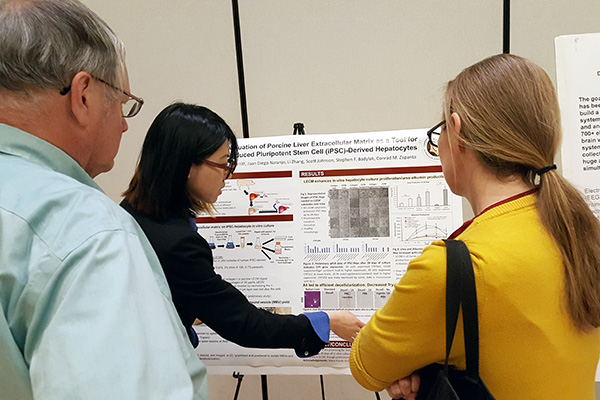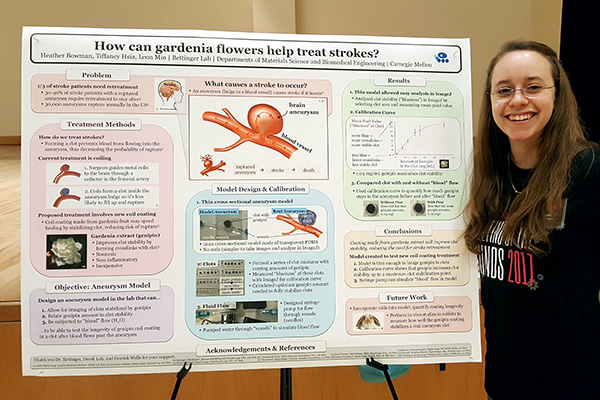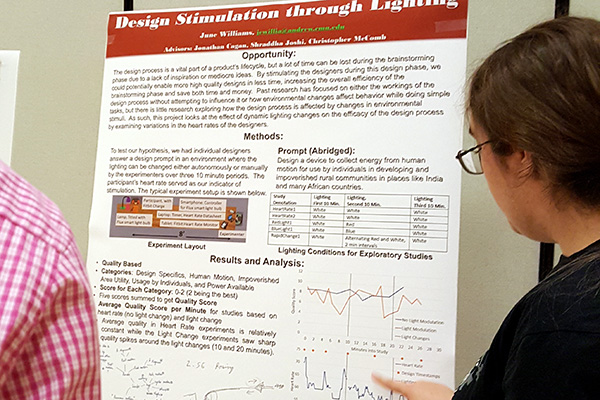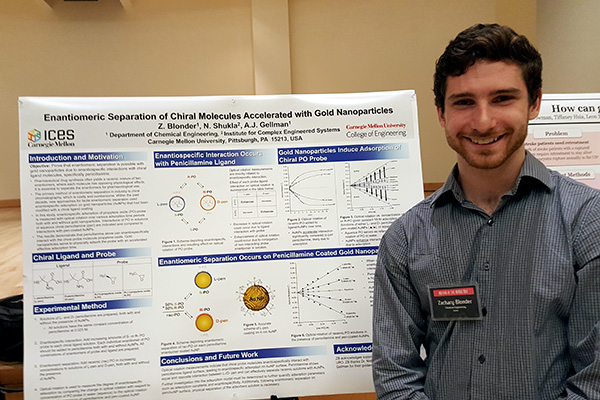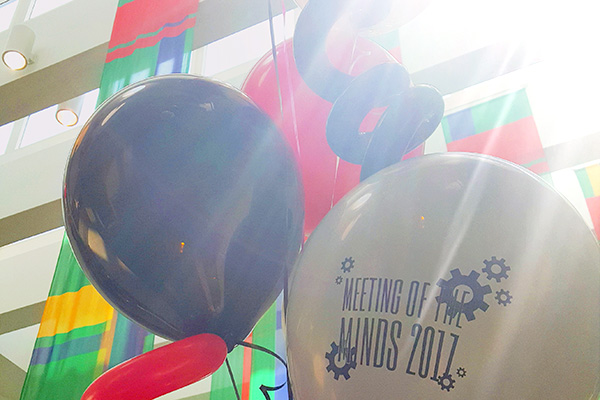Minds meet to showcase honors research
This weekend, graduating seniors across the university celebrated their transition to alumnihood. We’d like to take a moment to highlight some of our outstanding engineering graduates.
This weekend, students across the university celebrated their transition to alumnihood. Departmental and university-wide commencements took place all weekend, and we’d like to take a moment to highlight some of our outstanding graduating seniors, our honors recipients.
Each year, the Undergraduate Research Office at Carnegie Mellon University hosts the Meeting of the Minds, an all-day, campus-wide celebration of undergraduate research. As part of the Meeting of the Minds, the College of Engineering holds an annual competition for all of the graduating engineering undergraduates receiving honors distinction for their thesis research. The CIT Honors Research Poster Competition is a way for our honors students to be recognized for their hard work throughout their time at Carnegie Mellon, by displaying and explaining their research to the public.
This year’s competition was won by three spectacular student researchers, who displayed deep technical understanding and skillful communication of their subjects to the public. Their projects are outlined below.
1st place
Rinko Maeshima, ChemE/BME
Advisors: BME Associate Department Head Conrad Zapanta and Dr. Stephen F. Badylak from the McGowan Institute of Regenerative Medicine (MIRM)
Title of research project: Generation and evaluation of porcine liver extracellular matrix as a tool for culturing human induced pluripotent stem cell (iPSC)-derived hepatocytes
Patients in need of replacement organs can stay on the organ donor list for years, in wait of new hearts or livers. In order to address the nationwide organ donation shortage, Maeshima and her research team focused on developing an alternative method for generating livers—seeding non-human livers with human liver cells, to see whether this method of making non-human livers compatible with the human body would work in a future industry setting. The problem, according to Maeshima, is that hepatocytes, the human liver cells, once seeded, don’t always like to stick to the liver’s “scaffold”—the structural parts of the liver left over once the incompatible non-human hepatocytes have been removed. Fortunately, the scaffold is known to contain proteins that guide cells to grow better. Maeshima focused on testing whether the hepatocytes would stick to the scaffold when combined with substrates invented in the lab that used ground scaffold and proteins—also known as the liver extracellular matrix—as the base material. She found that the substrates that used liver matrix had a significantly improved impact on the human hepatocyte’s morphology and function on the formerly incompatible scaffold, in comparison to control groups using collagen. This finding suggests a more optimistic future for whole organ transplants and donations.
What she’s doing after graduation: Continuing to work in Dr. Badylak’s lab, then staying on at CMU to get her master’s degree in mechanical engineering.
2nd place
Zachary Blonder, ChemE
Advisor: Nisha Shukla, special faculty in the Engineering Research Accelerator
Title of research project: Enantiomeric separation of chiral molecules accelerated with gold nanoparticles
Chiral molecules are a pair of molecules that are mirror images of each other, like a left hand and a right hand, and an “enantiomer” is one of that pair. Blonder’s research was to perform the enantiomeric separation of molecules—separating mixtures of two enantiomers into each individual enantiomer. Many molecules have a “left-handed” and a “right-handed” chirality, or two mirrored forms that are synthesized together. In the pharmaceutical industry, drugs are made in massive quantities, and when these drugs are synthesized they contain both chiral components—one that will have the desired health effects, and one that can cause negative health effects if not removed. The current method of separating the positive and negative enantiomers is chiral chromatography, which is a costly and cumbersome methodology, so Blonder’s research was to develop a new method of enantiomeric separation, using coated nanoparticles of gold to adhere to the chiral molecules. By introducing gold nanoparticles and penicillamine (a product of penicillin) to propylene oxide (a common molecule used in pharmaceutical synthesis) and observing the optical rotation of this mixture over time, Blonder observed indication that one form of propylene oxide adsorbed to the coated nanoparticles while the other remained in solution. In these observations, Blonder saw an equal and opposite trend that suggests that, moving forward, the researchers would have success in physically separating the enantiomers through nanofiltration. The successful separation of these enantiomers would lend itself to the development of a cost-efficient and simple methodology of separating out drugs that could be incorporated into many separation processes in industry, which would be a great stride in reducing the cost of pharmaceuticals.
What he’s doing after graduation: Returning to Boston for work
3rd place
Lauren Relyea, ChemE
Advisor: ChemE Associate Professor Aditya Khair
Title of research project: Heat and mass transfer past slender bodies via a generalized reciprocal theorem
Relyea’s research was to look at the heat and mass transfer past “slender bodies”—pen-shaped objects, in which one axis is much smaller than the others—by developing a generalized mathematical theorem to determine these quantities. By putting these slender bodies into a flowing fluid, Relyea looked at how the body’s location in a flowing fluid would affect the transfer of heat, or how much excess convection there would be due to the body being in a flowing fluid. From there, Relyea used Fourier transforms and a reciprocal theorem to derive an equation that tells the researcher what that excess heat transfer is due to convection, based on the angle at which the axis of the body makes with the direction of the flowing fluid. In addition to being useful contexts where a researcher would want to see how a fluid affects the heat or mass transfer of any object of this shape—for example, in a reactor or heat exchanger—Relyea’s theorem can also apply to capacitance, or excess electrical charge in particles, which is often used when modeling DNA.
What she’s doing after graduation: Returning to New Jersey, where she will be working with Princeton Consultants Inc.
Additional finalists in the competition included Yifan (Jack) Wang (MechE/BME) and Anna Bandecca (ChemE/BME), whose projects, “Biocompatible molded housing of the pulmonary assist device” and “Pulmonary drug delivery using partial antibacterial perfluorocarbon liquid ventilation,” were both advised by BME Associate Professor Keith Cook.
Congratulations to all of our students who graduated this weekend!

